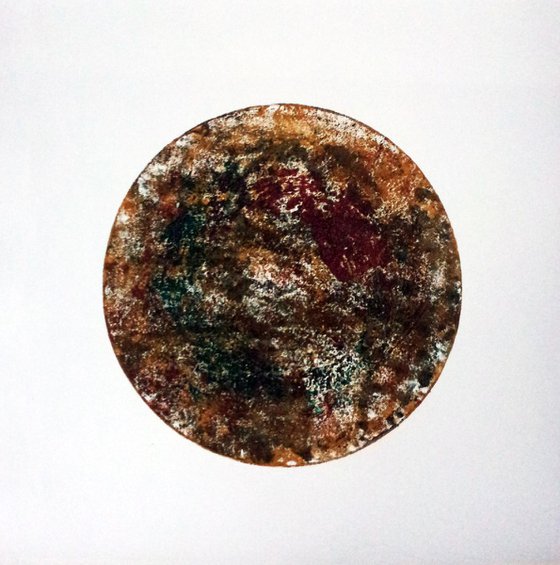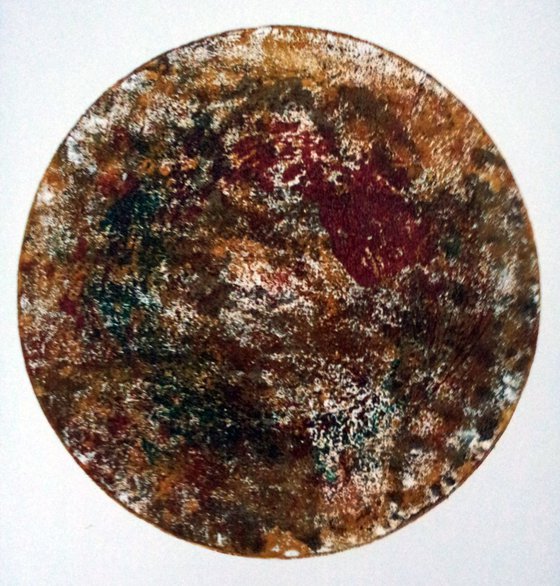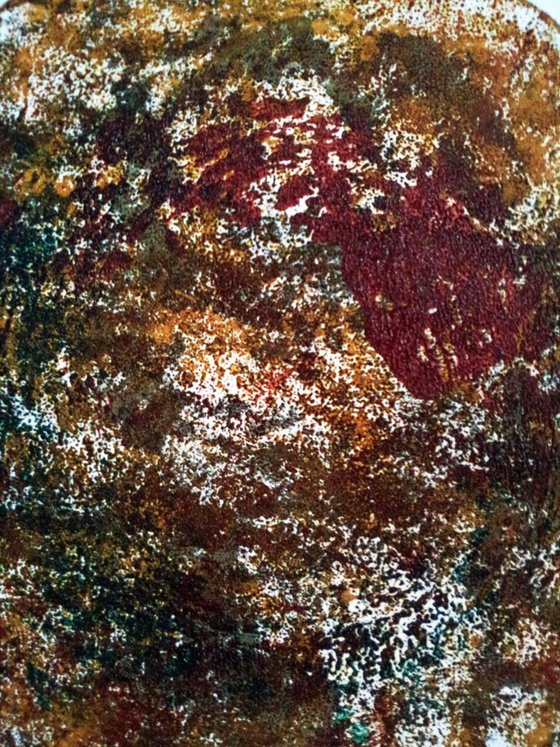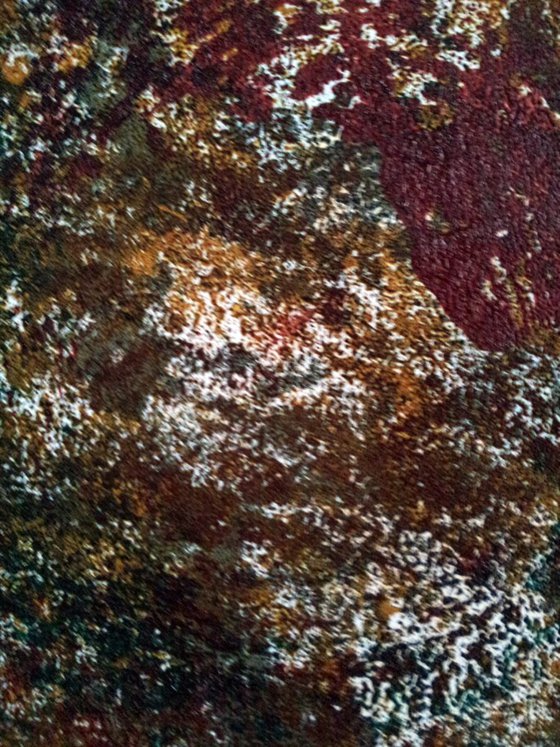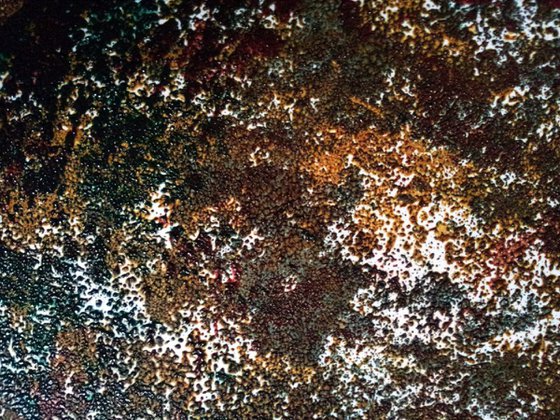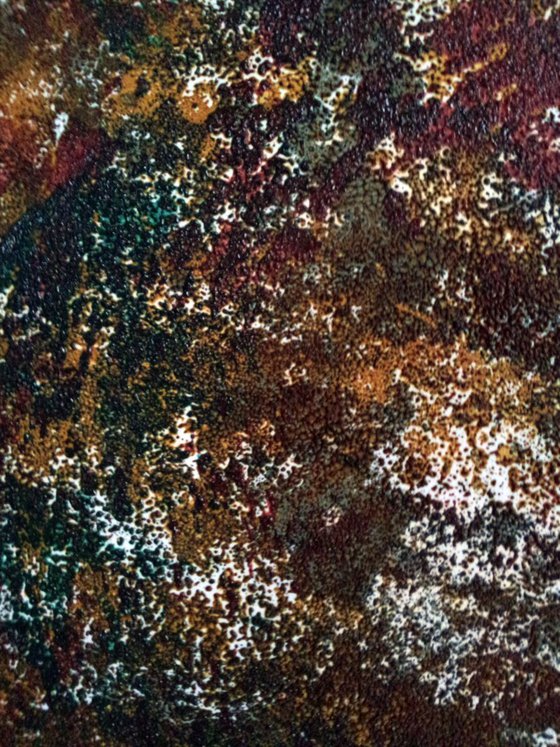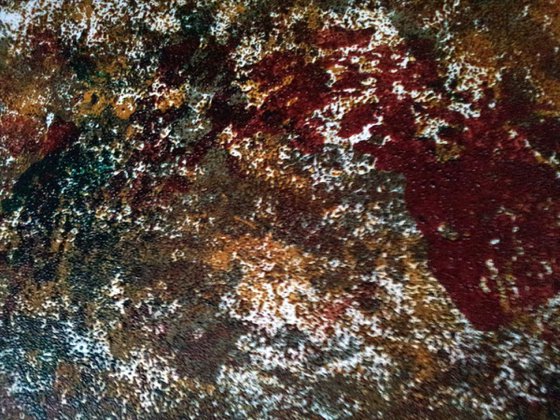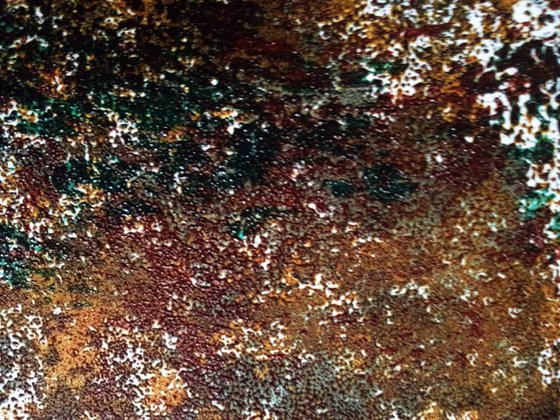Artwork description:
This image is inspired by my walks in the landscape and viewing the various aspects associated with the way humans have influenced its shape and how we have utilised materials from the earth for our survival and industrial production.
Since the early ages of humankind we have delved deep into the earth to mine minerals and other precious compounds for use in everyday items for adornment and war. Since the industrial age we have increased this exponentially and this series of works titled 'Anthropocene' work through thoughts and ideas associated with what is now called the Anthropocene Age, where by humans have had a dramatic effect on the earth and environment, producing a strata of history attibuted to the age of humankind coming after the Holocene era.
This image captures various aspects associated with the landscape, particularly concerning resonances with rocks. The material pigments are made from rock pigments collected from my walks in and around Watchet, Somerset, as well as pigments from industrial objects and tools I have come across in the landscape.
These forms take on the appearance of rocks with lichen and mosses; petri dishes with growths from materials collected, or akin to a thin slice of rock as seen in the geological science of Petrology.
The images explore the mixing of natural materials and industrially made materials as pigment, relayering to symbolise the new layers of strata we are now producing since the Industrial Age and the rise of mass production and corporationism.
The Anthropocene Age
The Anthropocene is a proposed epoch dating from the commencement of significant human impact on the Earth's geology and ecosystems. The Anthropocence thus includes, but also transcends, the duration of anthropogenic climate change. As of August 2016, neither the International Commission on Stratigraphy nor the International Union of Geological Sciences has yet officially approved the term as a recognized subdivision of geological time, although the Working Group on the Anthropocene (WGA) voted to formally designate the epoch Anthropocene and presented the recommendation to the International Geological Congress on 29 August 2016.
Scientists in the Soviet Union appear to have used the term "anthropocene" as early as the 1960s to refer to the Quaternary, the most recent geological period. Ecologist Eugene F. Stoermer subsequently used "anthropocene" with a different sense in the 1980s and the term was widely popularized in 2000 by atmospheric chemist Paul J. Crutzen, who regards the influence of human behavior on Earth's atmosphere in recent centuries as so significant as to constitute a new geological epoch. A January 2016 report on the climatic, biological, and geochemical signatures of human activity in sediments and ice cores suggested the era since the mid-20th century should be recognised as a distinct geological epoch from the Holocene.
Natural Materials: Fossil Black, Fossil Grey, Coleridge Red, Mariner Blue, Watchet White
Industrial: Indian Yellow, Rust from discarded metal, Phthalocyanine Blue
Materials used:
Handmade Natural and Industrial Pigments on Cartridge Paper, Medium, Linseed Oil, Dammar Oil, Seawater from the Severn collected from a hole left by a fossil hunter.
Tags:
#handmade ink #beauty #print #printmaking #industrial art #layers #environment #philosophy #layering #layers of paint #romanticism #printing #aesthetics #walks #entropy #pigmentary ink #anthropocene #industrail aestheticAnthropocene IV (2016)
Print
by Adam Grose MA RWAAN
19 Artist Reviews
£300
- Print on Paper
- From a limited edition of 1
- Size: 52 x 52 x 0.1cm (unframed) / 32 x 32cm (actual image size)
- Signed and numbered on the back
- Style: Organic
- Subject: Abstract and non-figurative
- Hurry only 1 left in stock
Artwork description
This image is inspired by my walks in the landscape and viewing the various aspects associated with the way humans have influenced its shape and how we have utilised materials from the earth for our survival and industrial production.
Since the early ages of humankind we have delved deep into the earth to mine minerals and other precious compounds for use in everyday items for adornment and war. Since the industrial age we have increased this exponentially and this series of works titled 'Anthropocene' work through thoughts and ideas associated with what is now called the Anthropocene Age, where by humans have had a dramatic effect on the earth and environment, producing a strata of history attibuted to the age of humankind coming after the Holocene era.
This image captures various aspects associated with the landscape, particularly concerning resonances with rocks. The material pigments are made from rock pigments collected from my walks in and around Watchet, Somerset, as well as pigments from industrial objects and tools I have come across in the landscape.
These forms take on the appearance of rocks with lichen and mosses; petri dishes with growths from materials collected, or akin to a thin slice of rock as seen in the geological science of Petrology.
The images explore the mixing of natural materials and industrially made materials as pigment, relayering to symbolise the new layers of strata we are now producing since the Industrial Age and the rise of mass production and corporationism.
The Anthropocene Age
The Anthropocene is a proposed epoch dating from the commencement of significant human impact on the Earth's geology and ecosystems. The Anthropocence thus includes, but also transcends, the duration of anthropogenic climate change. As of August 2016, neither the International Commission on Stratigraphy nor the International Union of Geological Sciences has yet officially approved the term as a recognized subdivision of geological time, although the Working Group on the Anthropocene (WGA) voted to formally designate the epoch Anthropocene and presented the recommendation to the International Geological Congress on 29 August 2016.
Scientists in the Soviet Union appear to have used the term "anthropocene" as early as the 1960s to refer to the Quaternary, the most recent geological period. Ecologist Eugene F. Stoermer subsequently used "anthropocene" with a different sense in the 1980s and the term was widely popularized in 2000 by atmospheric chemist Paul J. Crutzen, who regards the influence of human behavior on Earth's atmosphere in recent centuries as so significant as to constitute a new geological epoch. A January 2016 report on the climatic, biological, and geochemical signatures of human activity in sediments and ice cores suggested the era since the mid-20th century should be recognised as a distinct geological epoch from the Holocene.
Natural Materials: Fossil Black, Fossil Grey, Coleridge Red, Mariner Blue, Watchet White
Industrial: Indian Yellow, Rust from discarded metal, Phthalocyanine Blue
Materials used:
Handmade Natural and Industrial Pigments on Cartridge Paper, Medium, Linseed Oil, Dammar Oil, Seawater from the Severn collected from a hole left by a fossil hunter.
Tags:
#handmade ink #beauty #print #printmaking #industrial art #layers #environment #philosophy #layering #layers of paint #romanticism #printing #aesthetics #walks #entropy #pigmentary ink #anthropocene #industrail aestheticReturns and refunds
We want you to love your art! If you are not completely satisfied with your purchase you can return it free within 14 days, no questions asked. Learn more
Artist Reviews (19)
This artwork is sold by Adam Grose MA RWAAN from United Kingdom
